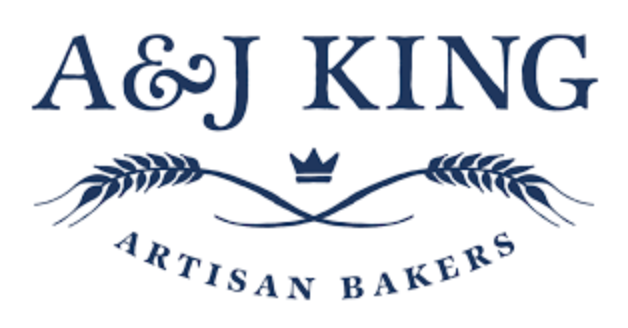Preferments and Sourdoughs for the Home Baker
Andy & Jackie King, A&J King Artisan Bakers, Salem, MA
Preferment:
A mixture of a fermenting agent – commercial yeast or sourdough – and it’s starchy food – usually flour – produced at least an hour before the final mix of the dough.
Fermentation:
The process of converting sugar to alcohol/lactic acid and gas using yeast and/or bacteria.
Baker:
A wrangler of microbes and variables.
Benefits of Preferments!
1.Increased yeast activity = lowered production time 2.Organic acids develop – in sourdoughs AND non-sourdoughs – producing better flavor and aroma 3.Keeping quality increases due to lowered pH 4.Dough strength increases, gluten bonds form with hydration
Drawbacks:
1.Baking production schedule is lengthened (passive time). 2.Good bread is inherently “riskier” to produce. 3. Everyone will ask for some of your sourdough culture.
Yeasted Preferment:
A preferment utilizing commercial yeast (rather than sourdough)
Sponge:
Short starter, usually loose. An hour or two. Liquid – many times milk – flour, and sugar to spike yeast activity.
Primary Usage:
To jam up yeast activity before the final mix. Flavor, aroma, etc. are usually not a strong consideration.
Great for:
Sweet rolls, filled items, heavily flavored doughs like hot crossed buns, etc. Warning: Don’t use too much sugar in these mixes. Sugar takes water from yeast, reduces yeast activity. If you have to use a lot of sugar, up the yeast amount or use osmotolerant yeast – it requires less water to be active.
Poolish:
An example of a liquid (or loose) yeasted preferment. 100% hydration. 12-16 hour pre-fermentation
Primary usage:
To lend a bubbly, more open crumb to slightly stiffer doughs. More organic acids well develop than a stiffer starter due to increased activity in more liquid environments. Great for: Less hydrated doughs, like baguette, that need strength for nice beautiful bursts but also require an mouse-hole crumb.
Biga:
An example of a stiff (or tight) yeasted preferment. 60% hydration, roughly. 12-16 hour pre-fermentation period.
Primary usage:
To lend strength to higher hydrated doughs. Some say give a nuttier aroma. Great for: Higher-hydrated doughs (especially Italian ones, if you want to be traditional) that also need body and rise, like Ciabatta.
Pate Fermente:
Old dough. It will be whatever your old dough’s hydration is. Can keep in the fridge for 2-3 days and used as an effective preferment for any dough you make. Warning: Will increase dough strength considerably, because of the lower hydration and salt content, so you might want to up your dough’s hydration to compensate.
Sourdough:
A symbiotic culture of wild yeast and bacteria, harnessed from flour and the air around us, that we keep alive in a medium of water (so the microbes can move around) and flour (it’s own food.)
Making Your Own:
Day 1: 6 oz white bread flour 6 oz whole rye flour (organic preferred) 12 oz distilled or dechlorinated water Mix all the ingredients and store in a covered container between 80°F or warmer for 24 hours. Day 2: 10 oz flour/rye/flour mixture 8 oz white bread flour 10 oz distilled or dechlorinated water There will be minimal, if any, activity at this point. Mix all the ingredients and cover. Keep at 80°F or warmer for 24 hours. Day 3: 10 oz sourdough culture 8 oz white bread flour 10 oz distilled or dechlorinated water You should start to notice small bubbles and/or foam forming at this point— you can now call it a (very weak) sourdough culture! If that is not happening, make sure your mixture is warm enough. It will not smell particularly nice at this point. Mix all ingredients and cover. Keep at 80°F or warmer for 24 hours.Day 4: 10 oz liquid sourdough 8 oz white bread flour 10 oz distilled or dechlorinated water Development should be continuing, with slightly larger bubbles forming as well as foam. Small amounts of liquid may form at the top of the mixture, which is normal. You should begin feeding 2 times per day at this point. Mix all ingredients and cover. Keep at 80°F or warmer for 12 hours – you’ll now be feeding twice a day (so you may want to set it up so that you’re not getting up at 3am. 8am-8pm works just fine.) Continue this 12-hour feeding schedule for at least 3 days. After one full week from your first mixture, your sourdough culture should be strong enough to begin maintenance feedings, which will contain a lower percentage of sourdough culture. You can also start using your regular tap water at this point: 2 oz liquid sourdough 8 oz white bread flour 10 oz 75°F tap water Once you have a healthy, vibrant starter chugging away, you can do one of two things. First, you can keep it on your counter and feed it every day. You can certainly get away with once-a-day feedings if you reduce your starter amount by half. If you plan correctly and know when your next bake is going to be, just switch back to your 12-hour feedings a couple of days before the big day so they can gain some momentum. OR, if you know you’re not going to be baking for a while, just give it a feeding and pop it in the refrigerator. When you know your next baking day, or you come to your senses re: the fad diet thing, pull the starter out. Give it 12 hours to warm up, and then give it at least 2 days of 12-hour feedings to get those yeast and bacteria back on track.

Jackie and Andy King met at the New England Culinary Institute, after which they moved to Portland, ME to pursue their careers in baking. After training at the Standard Baking Co., they decided to move to the North Shore of Massachusetts to try their hand at the bakery business. A&J King Artisan Bakers opened in June of 2006. They have two children, Emaline and Elliot, and a rotating cast of animals living with them. In 2013, they authored their first book, Baking by Hand, and finally got to take a real vacation (unrelated to the book). Woo-hoo! In 2017, they opened a 7500 square foot Boston Street baking facility and second retail store.
